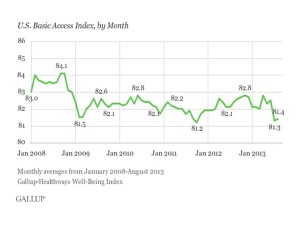 Over 1 in 5 people in the U.S. have not had enough money to buy food for themselves or their families in the past year, according to the August 2013 Gallup Healthways Index. This is as many consumers as those who couldn’t afford food during the deepest months of the last recession.
Over 1 in 5 people in the U.S. have not had enough money to buy food for themselves or their families in the past year, according to the August 2013 Gallup Healthways Index. This is as many consumers as those who couldn’t afford food during the deepest months of the last recession.
Lack of access to food is a challenge for a cadre of Americans who lack access to other basic needs such as shelter and health care. Gallup’s Basic Access Index looks at this market basket, and has found that Americans’ access to basic needs at 81.4 in August 2013 is near the historic low of 81.2 reached in October 2011. The chart illustrates this low point.
Access to health care is a component of basic needs measured in this Index. The proportion of Americans with health insurance or a personal doctor fell in August 2013, and is a near-new low compared with the bottom level seen five years ago in September 2008, Gallup found.
Health Populi’s Hot Points: Gallup concludes that the (tepid) economic recovery could be benefiting higher income Americans versus people at the lower end of the U.S. economic spectrum, where paying for basic needs can be a day-to-day, paycheck-to-paycheck challenge.
There is no universally-endorsed list of basic human needs: in 2013, the public-health minded observer would include food, clean water, shelter, clothing, sanitation, education and health care for sustaining life in any nation on Earth.
The economic recession has compromised Americans’ access to many of these needs, but in particular food and health care. Most people who work and receive insurance through their jobs have traded off wage increases for health benefits.
Consumers are bearing more costs out-of-pocket, especially as they look to enroll in the growing health insurance category of high-deductible health plans (HDHPs) and consumer-directed health plans (HDHPs that bundle in a financial health account). In the American household budget that includes food, health costs, housing, and other life-sustaining purchases, health costs compete with spending on food in resource-constrained spending. The Health Insurance Marketplaces open for shopping comparisons on October 1, 2013. Gallup points out that food stamp program (SNAP) cuts are being discussed in the U.S. Congress. The food stamp benefit will definitively decrease in November 2013 once the ARRA stimulus program burns out. Thus, Gallup foresees more consumers could lack access to food by year-end and into 2014.
The food-health nexus is huge: access to healthy food directly ties to whole health and peoples’ ability to self-care at home and stay well and out of the health system. Food marketers, media, health plans, providers, health insurers and medical suppliers (most especially pharma) can work together to connect people to healthy food, nudge people through artful plan design, and push engaging information and tools about the food-health connection to people who most need this support. Think: SoLoMo tying food, health, coupons, and financial wellness together.




 Thank you FeedSpot for
Thank you FeedSpot for